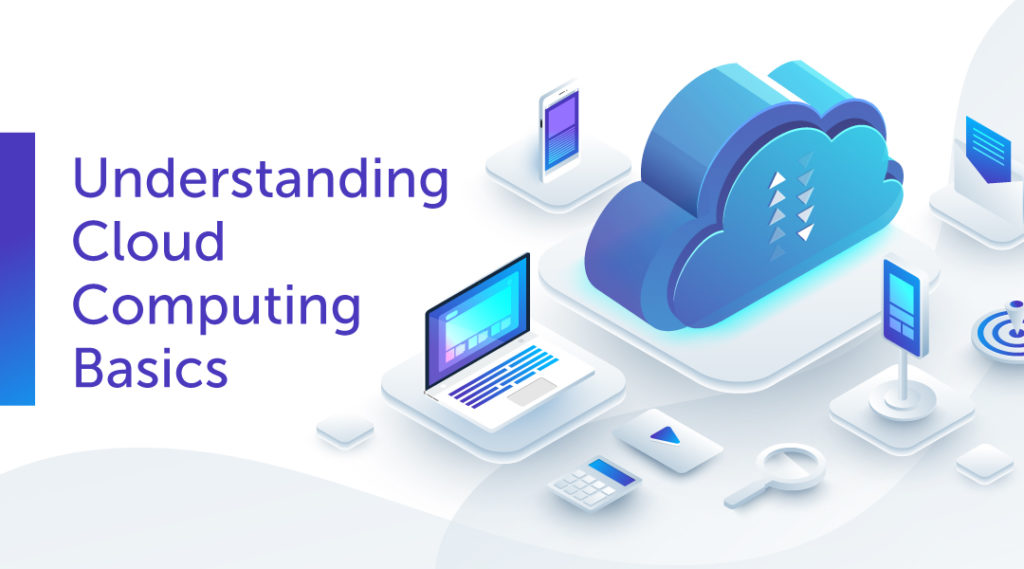Understanding Cloud Computing Basics
| 5 Min Read

There are few terms more ubiquitous in the world of computer science than cloud computing. Everyone has used cloud-based services at some point, but for many, the concept isn’t well understood. Here’s a quick introduction to cloud computing infrastructure.
What is cloud computing, in simple terms?
The easiest way to describe cloud computing is computing services delivered over the internet. Many types of services can be delivered via the cloud, from storage to networking to software to analytics, but the distinguishing feature is that they’re delivered remotely via an internet connection, as opposed to running locally on the end user’s individual device.
How does cloud computing work?
“The cloud” is a metaphor for a collection of shared resources, software and information. Cloud computing providers maintain networks of physical and virtual servers that contain the software and services to be provided. This is the “back end” of the cloud infrastructure.
The end user, whether an individual or a business, accesses the information stored on those servers by way of an internet connection. The idea is that the user can access the same information from any device, whether that’s a desktop, laptop, cell phone, tablet or even a borrowed computer at their local library. The end user’s device is the “front end” of the cloud infrastructure.
What are the types of cloud computing?
On the back end, there are three categories of cloud infrastructure:
- Public cloud: These cloud-based resources are owned by a third-party cloud service provider and kept in a centralized location. The provider manages the hardware, software and supporting infrastructure, while the end user accesses the cloud resources via a web browser.
- Private cloud: This type of cloud infrastructure is set up for exclusive use by a single organization. The cloud servers may be on-site at the organization’s physical location, or the organization may pay a third-party service to maintain resources for them. Regardless, the infrastructure uses a private network that can only be accessed by certain devices.
- Hybrid cloud: As the name suggests, a hybrid cloud contains a mix of public and private resources, with data and application sharing between the two.
What are the types of cloud services?
Broadly speaking, there are three main types of cloud computing services. These include:
- Infrastructure as a Service (IaaS): The baseline level of cloud computing is infrastructure, meaning servers, virtual machines, storage space, networks and operating systems. Essentially, this is virtual space that the end user can rent as needed, with the cloud computing provider taking care of physical maintenance and security.
- Platform as a Service (PaaS): This term refers to a cloud-based platform that allows users to develop, run and manage applications while the service provider takes care of the overall infrastructure. It contains a complete development and deployment environment with development tools, database management and more. The end user purchases licenses to use the platform and the tools on a pay-as-you-go basis.
- Software as a Service (SaaS): Also known as “on-demand software,” this refers to a cloud-based software program, such as office software, messaging, development software and consumer relationship management (CRM), to name a few. The end user pays for a license in order to access and use the software, but the software itself is hosted on the provider’s systems in the cloud infrastructure.
These three layers, IaaS, PaaS and SaaS, are sometimes called the cloud computing “stack” because they build on each other: PaaS contains IaaS, and SaaS contains all three. The idea is to allow end users to pay for only as much as they need, when they need it.
What are the advantages of cloud computing?
In addition to the overall cost-efficiency for the end user, using cloud infrastructure has a number of key advantages:
- Flexibility: Users aren’t limited to a single device or a single location. With the right security measures in place, anything that’s in the cloud can be accessed anywhere there’s an active internet connection.
- Data storage and backup: Information that is kept in any type of cloud storage is insulated from data loss or destruction of a business’s physical location. On the provider side, data is fragmented across multiple locations to limit the risk of data loss.
- Application building and testing: The scalability of cloud infrastructure adjusts to changing needs during the development and testing process, reducing both cost and time.
- Software on demand: When the actual software is stored in the cloud, any software updates only need to be done on the provider side, giving the end user immediate access to the latest version.
It’s easy to see why businesses are increasingly switching to cloud-based solutions for their IT needs. While the cloud is still a relatively new innovation, the growth of cloud infrastructure is only going to accelerate as users demand flexibility and scalability.
Ready to learn more?
Anyone who plans on pursuing a career in IT or a related field needs a strong foundation in cloud computing to succeed. It’s not enough to know how to use a particular system; the way to bring real value to an organization is to know how to recommend the right cloud solution for a given situation, then implement that solution in a secure and efficient manner. That skill requires a broad knowledge of cloud computing in general, plus the capabilities, challenges and costs of each cloud service.
While the specific products, services and providers may change, it’s abundantly clear that you need to understand the foundational cloud computing basics — the practical applications of how cloud computing works. Get started by pursuing your fully online B.S./B.A. in computer science at Eastern Oregon University Online.